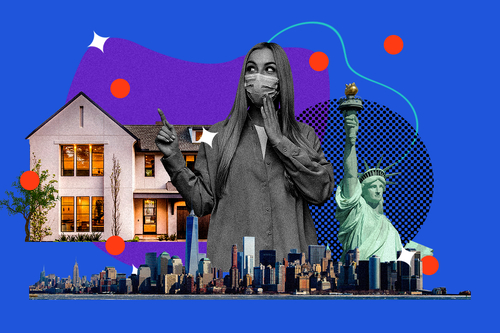

The New Normal: Top Real Estate Trends Fueled by COVID-19
Americans are moving away from big cities, looking for more space and affordability. Retail is struggling while logistic real estate booms.
Updated Jan 12, 2022
Many companies on MoneyMade advertise with us. Opinions are our own, but compensation and in-depth research determine where and how companies may appear.
Real Estate
Passive Income
Extra Income
It's often said the pandemic didn't create trends, it simply accelerated them. When it comes to real estate, the spread of COVID-19 put many of the previous decade's trends into overdrive.
Understanding these major shifts in the real estate market is crucial, whether you're thinking about buying a home one day or looking to invest in real estate. From the death of malls to the revival of American suburbs, here are some of the biggest 2023 trends in real estate that were propelled by the coronavirus pandemic.
Big cities no longer tower over "second-tier" cities
Big cities no longer tower over "second-tier" cities
American cities may not be the primary epicenters of cultural and technological innovation for much longer. During the first year of the pandemic, the biggest cities in the US—New York, Los Angeles, San Francisco, San Jose—saw the most dramatic population declines, according to new census data.
But while Americans are searching for affordability and more square footage, they aren't looking to give up many of the amenities that come with urban living. The areas experiencing the biggest influx of people right now are mid-sized cities and suburbs that offer easy access to major metropolitan centers.
According to the latest PricewaterhouseCoopers (PWC) Emerging Trends in Real Estate report, the top real estate markets are "18-hour cities" like Raleigh/Durham, North Carolina; Austin, Texas; and Nashville, Tennessee. Suburbs across the nation are also reinventing themselves to provide more urban amenities. Local businesses are opening up second locations in neighborhoods once dominated by chains, and many suburban historic downtown areas that were on their last limb are now being revitalized.
Square footage is king
Square footage is king
The shift toward less dense, more affordable areas doesn't come as a surprise when you consider the job and wage loss many Americans experienced in 2020 coupled with the need for more space. Big city living isn't very conducive to the "new normal," given the amount of time people now spend at home and the rise in remote work. Over one-third of US households have worked from home more frequently since the pandemic started, according to census data, and almost all families had to school their children from home for at least a while.
All of these trends support the meteoric rise in demand for larger single-family homes, along with skyrocketing property values and rents for that kind of real estate. While the housing market heat has some worried about a crash, most experts seem to agree that we're not in a bubble—primarily because the demand is largely being driven by low mortgage rates rather than irresponsible lending or speculation.
Some are waiting for the seller's market to calm down before investing in residential real estate, while others are taking advantage of low mortgage rates and high demand. While you might not be able to invest in single-family homes in growing urban centers where they're still going for well above market value, buying an affordable home in modestly-priced areas is great way to start investing in real estate.
Platforms like Roofstock take out most of the heavy lifting by selling affordable single-family homes (starting at just $20,000) that are already occupied by rent-paying tenants. This means you can earn passive income in the form of rent payments. Plus, the entire transaction can be completed remotely.
Roofstock
4.0
•
Real Estate
Malls are finally dead...and supply rooms are taking their place
Malls are finally dead...and supply rooms are taking their place
Suburban shopping malls have been on the decline for over a decade. Between the need for outdoor spaces that prevent viral spread and the increase in online shopping, delivery, and pick-up orders, the past year drove a final stake through obsolete retail spaces.
In fact, retail ranked last for investment potential amongst the six biggest commercial real estate property types in the latest PWC Emerging Trends in Real Estate report. That said, these changes in consumer shopping behavior have led to a sharp increase in demand for another type of commercial property: logistic real estate.
To keep up with the boom in online shopping, delivery, and pick-up orders, retail businesses need more space for inventory as well as delivery and shipping facilities. This need for more logistic space was only exacerbated by pandemic-related supply-chain issues that impacted the supply of a number of essential goods throughout the last couple of years. The PWC report emphasizes the massive competitive advantage retail companies with stable supply chain management processes now have, and a big part of that advantage comes from having proper logistic space.
If you've been following trends in commercial real estate and wondering how you can get some skin in the game, platforms like CrowdStreet allow everyday investors to invest in institutional-quality commercial real estate projects with as little as $25,000. Their listings often include storage, logistics facilities, and distribution centers.
CrowdStreet
3.0
•
Real Estate